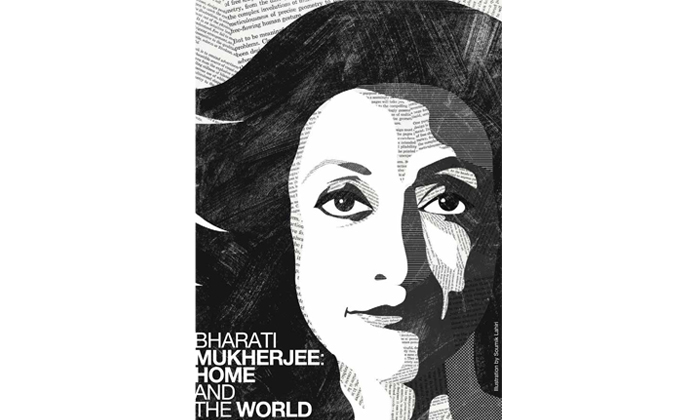What is it like to be an immigrant in the United States who has a lack of belonging and a world of isolation and is living off stolen dreams of nostalgia of an Indian culture that is frozen in time? What is it like to be a woman and be the centre of that family and a Bengali? Who are they and what do they feel? What is their voice? Now we know, thanks to the many novels and films such as Mira Nair’s ‘The Namesake’ but it was primarily started by a woman called Bharati Mukherjee who started writing her formed opinions about the Bengali immigrant woman’s world when the average Indian abroad in the 70’s were just about experiencing and managing to live through the crisis of the immigrant. That is where to me, Bharati Mukherjee holds a special place in my identification and love for the world of diasporic literature as I strongly feel she is one of the pioneers and most significant voices of a world that I was greatly a part of.
Bharati Mukherjee, who refers to herself as an American of Bengali-Indian origin is one of the first few voices to tell stories of the immigrant world-view, drawing from her own experiences, and thereby establishing herself as a distinguished contributor to American and world literature. Her most celebrated works reflect the duality of her pride in her Indian heritage, mingled with her celebration of America and its culture. Her books seem to imbibe this free spirit, belonging to a unique world-view, having loyalties to two different cultures at the same time. In her own words: “The immigrants in my stories go through extreme transformations in America and at the same time they alter the country’s appearance and psychological make-up.” (Excerpt from her interview in The Massachusetts Review)
Born in the early 40’s, in Calcutta, into an extraordinarily close-knit and upper-middle class Hindu Brahmin family, Mukherjee along with her siblings, were given ample opportunities, and thus pursued and received a top-of-the-line education. Her family moved to England after independence and stayed there until 1951, giving her a unique opportunity to develop and perfect her skills in the English language.
Coming back to her Calcutta roots, she completed her education in Loreto School and then her Masters from the University of Baroda. The next chapter of her life was in the United States where she received her M.F.A. from the Iowa Writers’ Workshop. Now based on age-old tradition, she was then supposed to return to India and submit herself to an arranged marriage with a man chosen by her father according to her caste and class. However, as fate would have it, she married a Canadian writer, Clark Blaise, on a mere impulse in a lawyer’s office, above a coffee shop, barely two weeks after meeting him. While this impulsive decision might have derailed her father’s plans for her personal life, her education and professional life remained on-course, as she received her M.F.A. the same year of her marriage, and then went on to earn her Ph.D. in English and comparative literature.
An overview of Mukherjee’s personal life and her work tells the story of a writer who has lived through varied cultural circumstances. First, as a colonial, then a National subject in India. Then she led a life of exile as a post-colonial Indian in Canada, where the major trials and tribulations of her life really took place as she faced discrimination, and hostility simply due to the fact that she belonged to the “visible minority” immigrant population. Her feelings of cultural separation while living in Canada are reflected in her first collection of short stories, ‘Darkness’ (1985), which was the follow-up to her first two novels ‘The Tiger’s Daughter’ (1971) and ‘Wife’ (1975) that were also written in the lap of such disharmony and confusion. Leaving the painful Canada chapter behind, she moved with her family into her life’s happier chapter as an immigrant, and then a citizen, of the United States of America.
This nomadic life of hers has been the rich source for her “new immigrant” literature which fuses her several lives and backgrounds together into the vortex of her unique viewpoint. While celebrating the “melting pot” of America, this writer of the Indian diaspora explores the condition of Asian immigrants in North America, with her witty observations, irony and prose style, highlighting the transformations taking place in South Asian women in the new world.
And then the National Book Critics Circle Award for Fiction for ‘The Middleman and Other Stories’ transported her into the elite company of the top ranking writers. In this collection Mukherjee plays the part of the middleman linking disparate worlds, telling her stories from varying perspectives, while being true to the core concept of self within a vast social framework. This collection differs from the rest of her works with its positive celebratory tone, with characters who are adventurers and explorers, rather than down-trodden refugees and outcasts.
Mukherjee’s most popular novel, ‘Jasmine’, is a development on an earlier short story from ‘The Middleman and Other Stories’. The story is about a young widow who uproots herself from her life in India and re-locates herself in America in search of a new beginning. It is a story of dislocation and relocation as the protagonist sheds lives and roles as she gradually moves westwards, trying each time to escape the fragments of her past. Mukherjee rejoices in the idea of assimilation and celebrates the story of a changing America, paving the way for the Jhumpa Lahiris and the Chitra Devakurni Bannerjee’s of the world who took over from where this pioneer left off.














